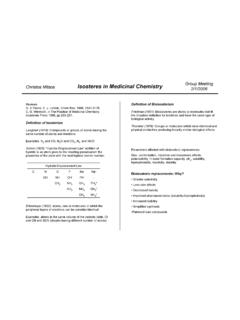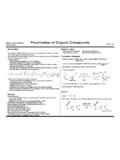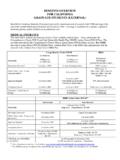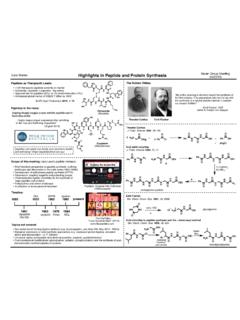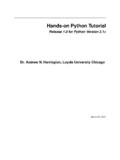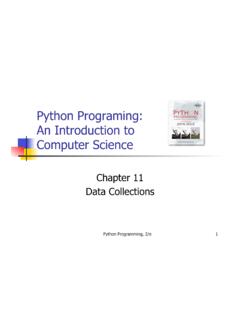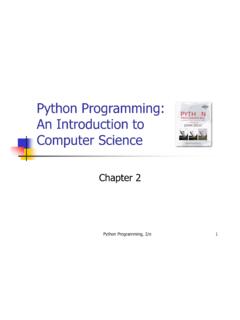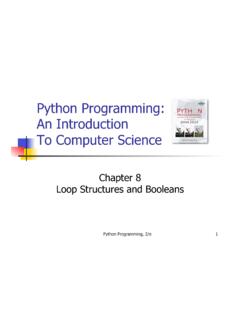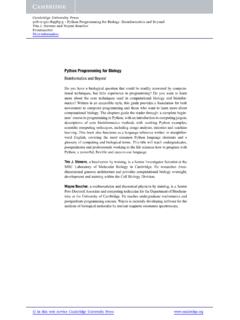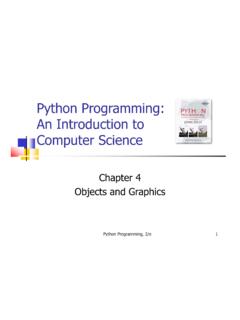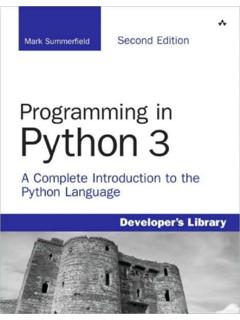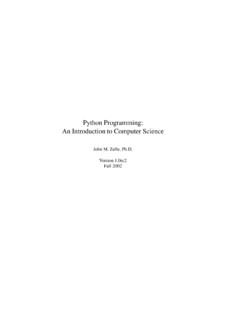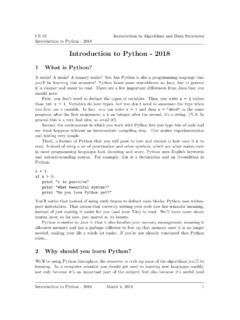Transcription of PYTHON: A PROGRAMMING LANGUAGE FOR SOFTWARE …
1 python : A PROGRAMMING LANGUAGE FOR SOFTWAREINTEGRATION AND DEVELOPMENTM. F. SANNERThe Scripps Research Institute10550 North Torrey Pines Road, La Jolla, the last decade we have witnessed the emergence of technologies such as libraries, Object Orientation, SOFTWARE architectureand visual PROGRAMMING . The common goal of these technologies is to achieve SOFTWARE reuse. Even though, many significantadvances have been made in areas such as library design, domain analysis, metric of reuse and organization for reuse, there are stillunresolved problems such as component inter-operability and framework design[1]. We have investigated the use of interpreted lan-guages to create a programmable, dynamic environment in which components can be tied together at a high level. This work hasdemonstrated the benefits of such an approach and has taught us about the features of the interpreted LANGUAGE that are key to a suc-cessful component problemOne of the challenges in bio-computing is to enable the efficient use and inter-operation of a wide variety ofrapidly-evolving computational methods to simulate, analyze, and understand the complex properties andinteractions of molecular systems.
2 In our laboratory we investigates several areas, including protein-liganddocking, protein-protein docking, and complex molecular assemblies. Over the years we have developed anumber of computational tools such as molecular surfaces, phenomenological potentials, various docking andvisualization programs which we use in conjunction with programs developed by others. The number of pro-grams available to compute molecular properties and/or simulate molecular interactions ( , moleculardynamics, conformational analysis, quantum mechanics, distance geometry, docking methods, ab-initio meth-ods) is large and growing rapidly. Moreover, these programs come in many flavors and variations, using differ-ent force fields, search techniques, algorithmic details ( , continuous space vs. discrete, Cartesian ). Each variation presents its own characteristic set of advantages and limitations. These programsalso tend to evolve rapidly and are usually not written as components, making it hard to get them to traditional solutionTypically, researchers have been using tools such as AWK and shell scripts to make such programs worktogether.
3 If that approach appears tempting initially, it has many inherent problems and limitations that willsurface in the long run. These include, a very low level of inter-operability: usually data is transferredbetween programs using files or pipes allowing only inter-operation at the program level rather than the func-tion level or at least functionality level. This makes its difficult, for instance, for a molecular dynamics code touse some third party electrostatic or molecular surface calculation package to derive a term used to drive thesimulation, or to use someone s visualization program tools to steer the simulation or monitor or play back tra-jectories. Such developments usually require substantial coding and often access to and understanding of thesource code. Such an approach also requires the creation of a large number of interfaces between differenttools. This makes it very hard to incorporate new methods into the tool set and therefore stifles the researcher screativity.
4 The level of code reuse offered by this approach is very low. For instance, every program operatingon molecules will need to implement its own parser for different molecular file formats, each having its ownbugs and weaknesses and each requiring coding effort. Finally, this approach often lead to very large scriptsthat are difficult to maintain, extend and solutions: Visual PROGRAMMING , specialized SOFTWARE suites ..The frustration of developing under these conditions has prompted us to investigate better methods for devel-oping code and integrating computational methods. Our first approach was based on using AVS (AdvancedVisualization System, from AVS Inc.). This environment has proven very useful for us over the last ten years,in terms of code reuse and capturing developments done by a set of transient collaborators, typically post doc-toral fellows who spend a few years in the laboratory before moving on. We have also encountered some limi-tations. AVS is a data-flow driven computation and visualization environment that comes with a large numberof processing modules for a wide variety of operations such as: data input, image processing, surface and vol-ume rendering, etc.
5 These modules can be linked together graphically using a network editor to create a pro-cessing stream for a particular visualization or computation. It also offers a mechanism for adding custom-designed modules for new computational methods. AVS users roughly fall into three classes distributed in apyramid. At the high end is the module programmer, typically writing C programs and making this code avail-able as AVS modules. The second, and larger class of users, are those who produce their own networks usingexisting modules. Although networks do not have constructs for loops or conditional execution, many visual-izations can be done at this level without writing a single line of code. The third, and largest class of users, arethose who use their own data with an existing network. One of the reasons AVS has worked well for us is prob-ably due to this visual PROGRAMMING paradigm creating this intermediate class of users which fits quite wellscientists in need of custom visualization who do not want to become programmers.
6 Of course AVS modularnature promotes code reuse that leads to rapid prototyping. This has enabled the scientist to concentrate on thevisualization process rather than the program used to visualize the , molecular modeling and bio-molecular visualization pose many challenging problems for data-flow environments. Molecules have a high-level of internal organization which it is often desirable to repro-duce in the programs operating on them. This is not always compatible with the simple data-types typicallyavailable in these environments. There are also problems of data duplication and inter-module , what we felt was the most restraining limitation in AVS was its lack of scripting capabilities. The AVSC ommand LANGUAGE Interface (CLI) merely consists of a set of commands and moreover it exposes only asubset of the kernel s functionality creating some serious limitations. We have lifted some of these problemsby embedding a python interpreter in an AVS module thus adding scripting capabilities [1].
7 Commercial and academic molecular modeling packages address these problems more specifically thanAVS, however, most of these packages are monolithic programs providing only a limited set of options foraltering the style of the visualization or extending the program to accept new types of data or to do new compu-tations. Since one of our missions is to investigate new computational methods and visualizations they did notappear to be the right centric approach and interpreted languagesPrograms are usually developed in a self centric way, meaning that theya re written to be self contained unitsaimed at solving a given problem of fulfill a given task. Some programs, like AVS, are designed to be extendedby adding new modules that can encapsulate new computational methods, but this always has to be donewithin the program s framework. And since programs are inherently specialized, this is bound to create prob-lems. To address this problem we decided to experiment with a LANGUAGE centric approach.
8 We use a high-level LANGUAGE as the core of our framework. Rather than writing programs we now extend this LANGUAGE withmodules or components implementing specific functionality. The high-level LANGUAGE serves as a glue to tiemodules and components together to rapidly create specialized applications. In some sense, the languagebecomes a scripting framework allowing fast prototypying of new applications. Developing extension mod-ules for the LANGUAGE corresponds to postponing specialization of code as much as felt, that an interpreted LANGUAGE would provide the flexibility, interactivity and extensibility neededfor such an approach and we started exploring using the three most popular interpreted languages: Perl, TCLand python . There are a number of articles comparing these three languages to each other as well as to com-piled languages such a C, C++ and Java [see for a list of arti-cles]. After some experimentation with these different languages we learned that all interpreted languages arenot create equal and each has its specific strengths and weaknesses.
9 Of course they all provide a scriptableframework that is interactive, flexible, extensible and embeddable but there are differences in style and philos-ophy that make one or another more compelling for a given has the largest user base and is excellent for surprisingly short scripts that do a lot of work, whichunfortunately can also be quite challenging to understand. This LANGUAGE offers good support for commonapplication-oriented tasks whereas python s elegant, and not overly cryptic, syntax emphasizes support forcommon PROGRAMMING methodology and promotes code readability and thus maintainability. Tcl, like Pythoncan be used as an extension LANGUAGE and a stand-alone PROGRAMMING LANGUAGE but it s support for data struc-tures is rather weak (traditionally everything is a string). Moreover, the lack of modular name spaces beforeversion hindered the development of large programs. All these languages span multiple platform and oftenprovide more platform independence than Java.
10 They all can be extended in C or C++.We settled on python for a number of reasons, including: it s concise and almost pseudocode-like syntax;its modularity; its object oriented design; its profiling, debugging, reflection, introspection and self documenta-tion capabilities; and the availability of a Numeric extension allowing the efficient storage and manipulation oflarge amounts of numerical data. python is as good a glue as any other interpreted LANGUAGE but in addition itcan be used to develop substantial extension is an interpreted, interactive, object-oriented PROGRAMMING LANGUAGE . It provides high-level data struc-tures such as list and associative arrays (called dictionaries), dynamic typing and dynamic binding, modules,classes, exceptions, automatic memory management, It has a remarkably simple and elegant syntax andyet is a powerful and general purpose PROGRAMMING LANGUAGE . It was designed in 1990 by Guido van many other scripting languages it is free, even for commercial purposes, and it can be run on practicallyany modern computer.
